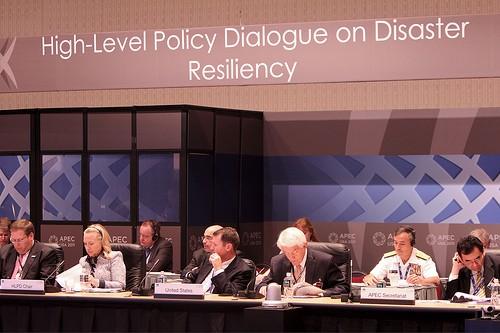Improving Disaster Preparedness Coordination Along the Pacific Rim
- Estimated
- 2 min read
In partnership with USAID and the U.S. Chamber of Commerce, we just launched the Pacific Rim Coordination Center (PRCC) at the annual APEC Leaders Meeting. The PRCC maps preparedness projects, visualizing these projects alongside risk and vulnerability data and recent historical events.

An example of the maps on data.pacificrimnetwork.org visualizing tropical cyclones in the region.
These three layers of data — projects, risk, and vulnerability, and 20 years of historical data — provide context for decisions makers from corporations and the government to see where there are gaps in disaster preparedness and coordinate together to address them. Right now the PRCC’s main focus is collecting more project data to be able to conduct a comprehensive analysis.
Secretary Clinton announced the PRCC platform in her remarks at the high-level policy dialogue on disaster resilience:
“I applaud today’s launch of the Pacific Rim Coordination Center. This is a partnership between the U.S. Chamber of Commerce and USAID that creates an online platform with open data and social networking and informational tools that citizens and officials can use to save lives.”

You can read more on the Secretary’s announcement by in the AFP story on “US offers disaster help to Asia-Pacific”)
The live site was officially presented to the APEC delegates by Nancy Lindborg, USAID’s Assistant Administrator for the Bureau for Democracy, Conflict and Humanitarian Assistance.

“We overlay these projects in the context of visualizing risk and vulnerability and recent historical events. It ultimately will enable organizations to make more data-driven decisions.”
Al Martinez-Fonts, Vice President of the U.S. Chamber of Commerce joined the Assistant Administrator in walking though the maps for the delegates, specifically focusing on why this partnership is important from the private sectors perspective, noting:
“I’ve learned that while we’re all in this together, we don’t always do the best job of building the right relationships before a disaster strikes. We’re too often silo-ed, even within sectors and organizations… With USAID, we’re trying to do a better job of communicating and coordinating the types of data and information that are needed in this resiliency work.”
CCTV (China Network Television) correspondent Daniel Ryntjes had the TV exclusive for on the launch:
We will be blog more details around the maps and the technology later this week.
What we're doing.
Latest